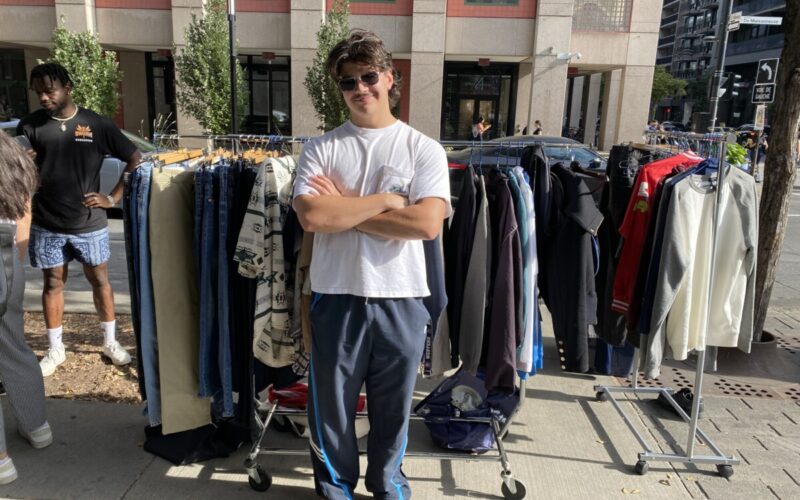A pop-up shop stacked with clothes appeared in front of the Hall building before reading week.
Days before reading week, students shuffled across campus to finish their classes, preparing for a well-deserved break. One student, however, had a different plan in mind.
Chris Aguiar, a Concordia student in economics, set up shop in front of the hall building with a pair of clothing racks chock-full of his personal garments. His goal: to bring back a moment from the thrifting culture he thought was lost.
“I think there’s a lot of people trying to exploit [thrifting] for personal gain,” Aguiar said. “It just takes away from the spirit of a thrift find. I’m gonna keep it dirt cheap just because I got it for dirt cheap.”
Aguiar has been thrifting for years, seeing its development from an alternative in affordable clothing into a mode of fashion. Over time, he’s built up an appreciation for the culture surrounding thrifting. Amassing a sizable collection, he hoped to clean some of it out to free up his closet and turn a profit.
After spotting a similar pop-up shop near Jeanne Mance park, he felt that setting up his racks in front of the hall building was obvious. Aguiar would be reaching his core target: university students in the middle of changing seasons.
“Obviously, [students] want to get something nice. But more importantly, they want to thrift something,” Aguiar said. “They want a good deal.”
According to Aguiar, regular avenues selling used clothing have become a hassle. As thrifting culture has grown in popularity, he’s noticed a large uptick in prices at thrifting stores. Moreover, online thrift stores like Depop take a percentage of the sales earned by the vendor.
A Concordia-graduated designer, Hannah Silver King, works with deconstructed garments, meaning her designs are often inspired or made from used material. This process is known as upcycling and it often has her using material from thrifted items. She admired Aguiar’s efforts in selling clothes at fair prices, as she herself had noticed the recent rise in thrifted items’ prices.
“There’s definitely a big market for it now, especially online,” King said. “If we can create this circularity [reselling thrifted clothes], I mean why not? Instead of throwing things away.”
King believes that most people wouldn’t have the resources to do as Aguiar had done—most people looking to sell their clothes would have to follow the beaten path, ultimately opting in to local thrift stores that might mark-up prices.
As thrifting continued its journey into mainstream culture, trends naturally emerged. Some, a contributing factor into the rising costs of recycled clothing. “A lot of stores decide to curate thrifted clothing. These vendors are going to the bins and they’re picking what’s cool and selling them for triple the price,” said Quinn Kuperhause, director of business relations for the Concordia Fashion Business Association. “It’s absolutely ridiculous.”
With the rise of so-called “vintage” clothing stores, Kuperhause explained how thrift stores would have to compete for the market, which is another reason for rising prices. She sympathized with Aguilar and thought his pop-up shop was a breath of fresh air in what she believes is a heavily saturated market.
Outside of thrifting, Aguiar hoped to incorporate his passion for fashion into selling denim jeans which he produces himself. As for his pop-up shop, he claimed its week-long stay at the Hall building would be cut short as the cold weather sets in.
“I think it’s good that people want to recycle and reuse clothes more often. Everyone deserves to have drip,” Aguiar said.




